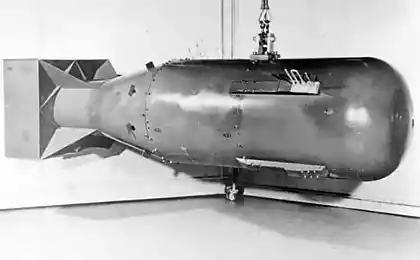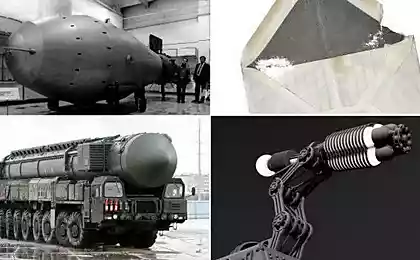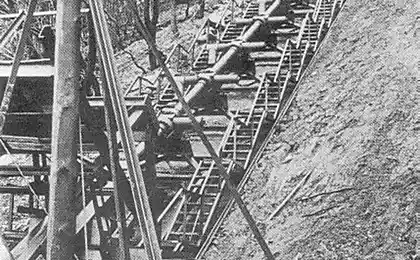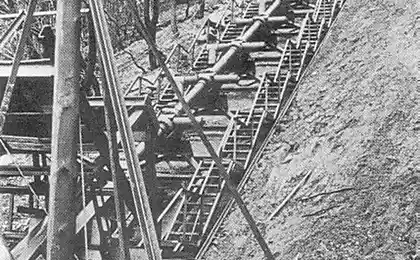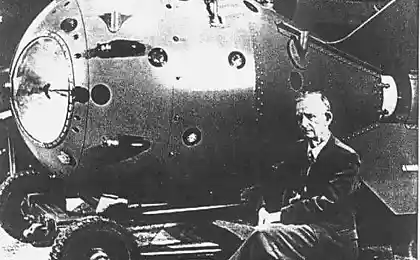997
The bomb Hs 293 received index.
By the end of 1942 in the Atlantic was a difficult situation for Germany. Ships anti-Hitler coalition became more sea transport is gaining momentum as a serious opportunity to stop them almost was not. Moreover, the beginning of the 43rd British and American ships began receiving solid anti-aircraft weapons. For example, the British cruiser HMS Belfast at the time of adoption of the system in 1939, had just eight 102-mm anti-aircraft guns. Over time, to strengthen the defense it had been mounted 40-mm automatic cannon Bofors (9 Single-quad and eight units) and about ten 20-mm guns, not including heavy machine guns. Obviously, the most effective anti-ship means the time - bombers and torpedo bombers - in this situation forces lost a significant part of its chance of a successful defeat of the enemy ships. Because of the strong German counter anti-aircraft pilots had to drop bombs and torpedoes from high altitudes and distances, respectively. Much of the ammunition of the goal.
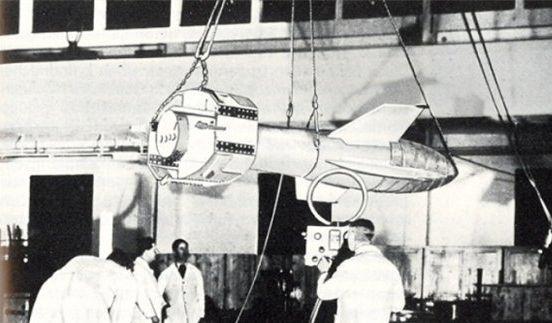
Henschel Hs 293
There is a serious need for a new weapon that would unite a good range and excellent accuracy for the time of impact. It should be noted, the general concept of such ammunition has been proposed as an engineer G. Wagner in 1939, but then for some reason it has not received proper development. Wagner suggested that a small likeness of the airframe and to equip it with control systems, warhead, etc. In this case, the bomber would drop bombs from a safe distance from the cover of anti-aircraft targets, and to direct it with commands. Guide Luftwaffe offer Wagner a little interested. Special preference program have not given, but did not close. The development of new ammunition began in the 40 th company to "Henschel". The planning bomb received index Hs 293.

By December of the same year we were ready a few prototypes of a new bomb. Structurally, they are small aircraft midwing classical scheme. In front of the housing bomb placed an explosive charge, borrowed from aircraft bomb SC-500 - 300 kilograms Amatol. In the back of the Hs 293, in turn, establishes control equipment and empennage. Tapered wing span 3, 1 meter installed in the middle of the bomb. Under the bomb casing suspended accelerator model Walter HWK 109-507. According to the authors of the project, he had to give bomb initial velocity required for long-range flight.
The first prototype of planning bomb Wagner belonged to the version of the draft Hs 293V-2. The previous version - Hs 293V-1 - was left in the drawings, and in fact became a pilot project of the new weapon. December 16, 1940 was made the first trial reset controlled bomb. As the carrier used a modified bomber He-111. It set the radio equipment control sight for navigator-bombardier, through which he had to follow the flight of the bomb, as well as a special heating system. The compressor and the heating element inside the bomb summed warm air, so that all its systems are functioning normally. Despite the best efforts of engineers and test pilots, the first drop bombs was unsuccessful. Branch Hs 293 from the carrier passed normally, accelerator dispersed bomb, but the navigator-bombardier was not able to get it at least in the target area. Fortunately for the company, "Henschel" it was not the fault of the design. Just a worker on the assembly of mixed plug wires. Because of this, the ailerons bombs began to work properly - with the team, "left bank" bomb raised left wing and vice versa. Investigation into the causes of the incident did not take long, and the second test planning bomb, after appropriate checks, spent only two days after the first. This time it worked cleanly and bomb dropped to 5, 5-6 kilometers from the conditional goal, hit the area painted on the ground targets. It was subsequently conducted several dozen educational bombings.
1.Dornier Do-217K-3 Hs. 293A pole suspension 2.Heinkel He-111H resets Hs. 293 3. Hs. 293 goes to the goal

In the course of further work on the project is planned to bomb Hs 293 has undergone several design changes. So, almost immediately after the start of the test at the end of wing panels were installed new pyrotechnic tracers. They were intended to facilitate the tracking of the flight path bombs. It should be noted, the original developer tracers quite satisfied and pilots for brightness and visibility. But the length of the combustion is poor. During several test bombing evolved a situation where the most crucial moment of its flight bomb becomes almost not visible to the operator. And all because of the tracer burns out quickly. As a result, by adjusting the composition of the mixture during the combustion of checkers has been brought to 110 seconds, which is considered sufficient for combat use. Another problem lay in the Hs 293 accelerator. In tests it was more or less normal, but in the course of combat operation was discovered a serious lack of liquid engine Walter HWK 109-507. The fact that the drill technique could not provide as "greenhouse" conditions that were in the trials. In particular, a cylinder of compressed air for ejecting fuel used, often filled with a simple atmospheric air. Due to the natural moisture content of injected air and temperature changes during operation of the pneumatic system often froze some valves and valves, so that the fuel supply. First Reyhsministerstva aviation employees suggested using another liquid accelerator production BMW. Soon, however, the idea of planning to bomb LRE refused to do, and Hs 293 steel complete solid booster WASAG 109-512. According to its characteristics, it was close to the engine, "Walter," but had no inclination to a sudden stop working. Finally, just before adopting a bomb Hs 293 was created with the management of its modification through a wired channel. Coils with a thin cable placed inside the wing.
Hs 293A

During the two years of tests (late 40th to the end of 42 th) combat performance of new charges were brought to the excellent value. An experienced crew of the aircraft carrier could drop bombs at a distance of 14-16 kilometers from the target at an altitude of 5-6 km, and laid in a relatively small area around it to half of all bombs. Of course, this might not be sufficient to defeat, say, ship. But in those days fifty percent hit on reset at a distance was an extremely successful indicator. In early 1943, planning to bomb Hs 293A was put into service and began mass production. In April of that year on the basis of group II bomber squadron hundredth Luftwaffe (II / KG100) began the formation of a special aviation unit, armed with a new guided munitions. The group used bomber Dornier Do-217. Due to its characteristics, this plane could simultaneously carry just two glide bombs. In late July 43rd II / KG100 was transferred to the Bay of Biscay to combat the Allied ships. Around this same time, it was formed by a group II / KG40.
The first combat use of the bomb Hs 293A was held August 25, 1943. Then, the connection of the 12 bombers found in the area patrolling British 40th Escort Group. From a safe distance the Germans dropped a few bombs, but did not achieve much success. Sloops HMS Bideford and HMS Languard received minor damage, one sailor "Bideford" died. The reason for the failure of the Germans lay in the accuracy and technical problems. So, get to the "Bideford" bomb did not detonate properly, and the four Hs 293A, which exploded near the "Lenguardom", because a miss could not cause serious damage to the sloop. Nevertheless, the possibility of a new planning bomb have been demonstrated in a real combat situation. Two days later the attack is the English sloop HMS Egret and the Canadian destroyer Athabaskan. German bomb landed right in the English ship artillery cellar. "Egret" sank. Canadian sailors were more fortunate - "Etebaskan" only received heavy damage. During the year the combat use of unit II / KG100 using bombs planning Hs 293A sank 17 British and American ships and caused damage of varying severity has 15. It is noteworthy that the effectiveness of the pilots II / KG100 and II / KG40 was growing along with the number of combat applications. For example, from February to August 44th on the account of both the bomber group has no damaged ship, but only flooded. The result of the raids was the decision by German bombers allied commanders to withdraw their ships further away from the Atlantic coast of Europe. Because of this the German submariners were able to move through the Bay of Biscay, almost no risk of being detected. The last case of successful combat use Hs 293A anti-ship belongs by 15 August the 44th. Then the German pilots from the South of France sank two American tank landing ship and damaged another. Because of the successful Allied offensive in Western Europe in the autumn of the 44th, the Germans left virtually no opportunities to make flights to patrol the Bay of Biscay and the other coastal zones. Finally, just last combat use bombs Hs 293A occurred in April 1945. Trying to somehow delay the advance of the Red Army, the Nazis attempted to destroy some bridges over the Oder. Due to anti-Soviet fighter aircraft bridges hardly affected. The offensive continued.
Hs-293D with telenavedeniem

The operator directs Hs-293

Based on the design of the bomb Hs 293 was developed several modifications:
- Hs 294. Initially, anti-ship ammunition. Development was launched in 1941 in order to ensure a reliable defeat enemy ships. The essence of the ideology of the project Hs 294 is that the bomb should fall into the ship below its waterline. For this bomb got a new body shape, wings completed discharged, and dispersal was carried by two boosters. In late 1942, tests were begun, and all, according to some sources, was collected about a hundred of these bombs. Data on the use of combat there;
- Hs 295. The advanced version of the Hs 293A. It is updated almost all the equipment and design. Thus, the body has a more streamlined bombs lines, control equipment on the radio replaced the more interference-free, and one solid booster gave way to two. The 44th had started work on the equipment the bomb television guidance system, but this version of the Hs 295 was not even embodied in the metal. Total was done about 50 such bombs, but the Germans did not have time to apply them in a real situation.
FX-1400
Developments G. Wagner are completely satisfied with the Luftwaffe against the combat effectiveness. With regard to financial and technological side of things, there were complaints. For mass production required a more simple design. Yet in 1938 Dr. M. Kramer began experiments to improve the accuracy of bombs SC250. As G. Wagner, he eventually came to the conclusion about the need to equip a major bomb guidance equipment. In 1940, Kramer interested achievements and his leadership of the Luftwaffe were sent to continue the creation of a new ammunition in the firm Ruhrstahl. At the same time, customers need to increase the capacity of the future warhead guided bombs - like the Hs 293 project Cramer had to be based on existing bombs. This time, choose PC1400 caliber 1400 kg.
Given the characteristics of the original bomb, Kramer began to develop an appropriate "kit" and control equipment. The result of the project FX1400 or Fritz X was a new guided munitions, looks significantly different from the creation of Wagner. Fritz X casing cast from steel, and in some places had a wall thickness of up to 15 centimeters. In the middle part of the body X-shaped installed four wings, and the rear - the tail assembly of the original form. Four planes in the form of a plus (two fin and stabilizer with elevator) were closed oval-shaped piece of light. There Kramer placed in the tail control equipment and tracer to facilitate the operator's bomb. Because of the tracer in the rear part of the body at one time there was a version of the rocket engine, but in any version thereof FX1400 had. The thick walls of the housing bomb prompted designers to an original idea of its application. Fritz X bomb had to drop from a height of at least 4000 meters. Dropping the bomb becomes a speed at which can penetrate aboard the ship and explode inside. For this reason, the bomb had a fuse with a delay. Contact fuse was not provided.
The first prototype bomb FX1400 were taken to the landfill under Karlskhafenom in February 1942. However, weather conditions have given rise to complete the test. Several weeks were spent on the relocation of testers in Italy Foggia to the landfill. Fritz X was first collected much neater Hs 293 and the test went quite well. Most of the time was spent on training scorers operators and testing of aircraft radio equipment and the most bombs. By the fall of the 42-th test pilots were able to reach the probability of hitting the target of 50%. It also turned out that the dropped bombs from a height of not less than six kilometers it is able to penetrate 130 mm armor deck. Hit bombs FX1400 in the ship - in conjunction with the guidance system and undermining the charge with a delay - as did the Germans, did not leave the enemy sailors virtually no chance.
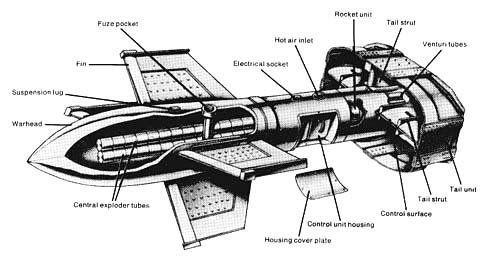
In the autumn of the same 42-year-based Granz it was formed 21 th educational-test command. The purpose of its creation was to train front-line pilots use the new ammunition. A little later, 21th Command will be converted to group III of the 100th Bomber Squadron (III / KG100). "Baptism of fire» Fritz X was held until the end of July 1943. German pilots found several British ships in the harbor of Syracuse and Augusta. There were two attacks and both failed. Further application of the new bomb also was not too successful. The high altitude relief in fact turned out to be a problem: FX1400 can not be applied in a cloud below 4000 meters. The second catch is gliding application "Fritz" lay in the electronic countermeasures on the part of the British. Interestingly, the exact data on the use of "jamming" is still there. But it is known that the British gave EW more important than the Germans. However, Kramer has 41-year guidance system developed an alternative to the transfer of command wire. Each bomb was supposed two coils: one bomb on the console, and the other - on the console of the aircraft carrier. The total stock of wire was 30 kilometers for each bomb. The latter problem bombs FX1400, as it turned out, "rose" from the fact that initially was seen as an advantage. High armor penetration was helpful when attacking heavy ships like battleships. But even commercial vessels and destroyers to disperse bomb sometimes simply punched through. Blaster did not have time to react in time and the undermining of the charge occurred only when the FX1400 was already in the water. Of course, the desired effect had such a blast. Because of all the reasons put together bombs Fritz X, according to available data, only one ship sank. It was the Italian battleship Roma. Five other Italian, American and British ships were only seriously damaged.
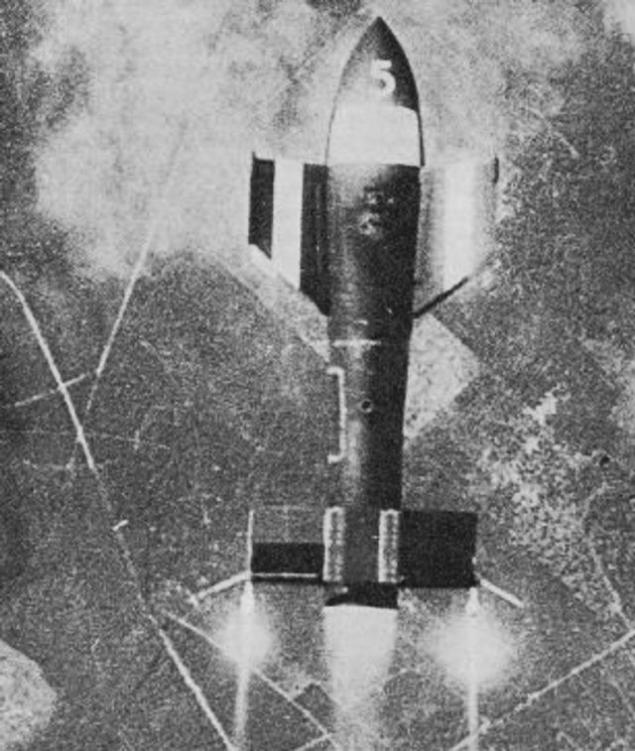
The actual low combat capability ultimately affect the fate of the entire project. 19 November 43rd group III / KG100 was ordered to return to Germany. There's pilots were trained to use the bomb Hs 293A.
BV 226 and BV 246
The latest in the "race" to build the planned controlled bombs joined the firm Blohm & Voss. Project BV 226, created under the direction of Dr. R. Fogg, had exactly the same purpose as described above. The difference is the chosen method of implementation of the idea. First of all, it is worth noting the relatively small bomb combat weight - 730 kg, 435 of which projects are in a combat unit. Simultaneously, the BV 226 had a body and a high aspect ratio wing, which made her look like a glider. Several prototypes of the bombs in 1942 were shipped to the test. In its original form, the draft continued BV 226 has received: the lack of impact of competitive advantage.
Second Life development Fogg gave failures bomb Fritz X. The first issue will munition from "Rurshtal" forced the leadership of the Luftwaffe pay more attention to alternative projects. The project company "Blomm und Voss" was interesting lack of strict restrictions on the height of drop bombs.

Henschel Hs 293
There is a serious need for a new weapon that would unite a good range and excellent accuracy for the time of impact. It should be noted, the general concept of such ammunition has been proposed as an engineer G. Wagner in 1939, but then for some reason it has not received proper development. Wagner suggested that a small likeness of the airframe and to equip it with control systems, warhead, etc. In this case, the bomber would drop bombs from a safe distance from the cover of anti-aircraft targets, and to direct it with commands. Guide Luftwaffe offer Wagner a little interested. Special preference program have not given, but did not close. The development of new ammunition began in the 40 th company to "Henschel". The planning bomb received index Hs 293.

By December of the same year we were ready a few prototypes of a new bomb. Structurally, they are small aircraft midwing classical scheme. In front of the housing bomb placed an explosive charge, borrowed from aircraft bomb SC-500 - 300 kilograms Amatol. In the back of the Hs 293, in turn, establishes control equipment and empennage. Tapered wing span 3, 1 meter installed in the middle of the bomb. Under the bomb casing suspended accelerator model Walter HWK 109-507. According to the authors of the project, he had to give bomb initial velocity required for long-range flight.
The first prototype of planning bomb Wagner belonged to the version of the draft Hs 293V-2. The previous version - Hs 293V-1 - was left in the drawings, and in fact became a pilot project of the new weapon. December 16, 1940 was made the first trial reset controlled bomb. As the carrier used a modified bomber He-111. It set the radio equipment control sight for navigator-bombardier, through which he had to follow the flight of the bomb, as well as a special heating system. The compressor and the heating element inside the bomb summed warm air, so that all its systems are functioning normally. Despite the best efforts of engineers and test pilots, the first drop bombs was unsuccessful. Branch Hs 293 from the carrier passed normally, accelerator dispersed bomb, but the navigator-bombardier was not able to get it at least in the target area. Fortunately for the company, "Henschel" it was not the fault of the design. Just a worker on the assembly of mixed plug wires. Because of this, the ailerons bombs began to work properly - with the team, "left bank" bomb raised left wing and vice versa. Investigation into the causes of the incident did not take long, and the second test planning bomb, after appropriate checks, spent only two days after the first. This time it worked cleanly and bomb dropped to 5, 5-6 kilometers from the conditional goal, hit the area painted on the ground targets. It was subsequently conducted several dozen educational bombings.
1.Dornier Do-217K-3 Hs. 293A pole suspension 2.Heinkel He-111H resets Hs. 293 3. Hs. 293 goes to the goal

In the course of further work on the project is planned to bomb Hs 293 has undergone several design changes. So, almost immediately after the start of the test at the end of wing panels were installed new pyrotechnic tracers. They were intended to facilitate the tracking of the flight path bombs. It should be noted, the original developer tracers quite satisfied and pilots for brightness and visibility. But the length of the combustion is poor. During several test bombing evolved a situation where the most crucial moment of its flight bomb becomes almost not visible to the operator. And all because of the tracer burns out quickly. As a result, by adjusting the composition of the mixture during the combustion of checkers has been brought to 110 seconds, which is considered sufficient for combat use. Another problem lay in the Hs 293 accelerator. In tests it was more or less normal, but in the course of combat operation was discovered a serious lack of liquid engine Walter HWK 109-507. The fact that the drill technique could not provide as "greenhouse" conditions that were in the trials. In particular, a cylinder of compressed air for ejecting fuel used, often filled with a simple atmospheric air. Due to the natural moisture content of injected air and temperature changes during operation of the pneumatic system often froze some valves and valves, so that the fuel supply. First Reyhsministerstva aviation employees suggested using another liquid accelerator production BMW. Soon, however, the idea of planning to bomb LRE refused to do, and Hs 293 steel complete solid booster WASAG 109-512. According to its characteristics, it was close to the engine, "Walter," but had no inclination to a sudden stop working. Finally, just before adopting a bomb Hs 293 was created with the management of its modification through a wired channel. Coils with a thin cable placed inside the wing.
Hs 293A

During the two years of tests (late 40th to the end of 42 th) combat performance of new charges were brought to the excellent value. An experienced crew of the aircraft carrier could drop bombs at a distance of 14-16 kilometers from the target at an altitude of 5-6 km, and laid in a relatively small area around it to half of all bombs. Of course, this might not be sufficient to defeat, say, ship. But in those days fifty percent hit on reset at a distance was an extremely successful indicator. In early 1943, planning to bomb Hs 293A was put into service and began mass production. In April of that year on the basis of group II bomber squadron hundredth Luftwaffe (II / KG100) began the formation of a special aviation unit, armed with a new guided munitions. The group used bomber Dornier Do-217. Due to its characteristics, this plane could simultaneously carry just two glide bombs. In late July 43rd II / KG100 was transferred to the Bay of Biscay to combat the Allied ships. Around this same time, it was formed by a group II / KG40.
The first combat use of the bomb Hs 293A was held August 25, 1943. Then, the connection of the 12 bombers found in the area patrolling British 40th Escort Group. From a safe distance the Germans dropped a few bombs, but did not achieve much success. Sloops HMS Bideford and HMS Languard received minor damage, one sailor "Bideford" died. The reason for the failure of the Germans lay in the accuracy and technical problems. So, get to the "Bideford" bomb did not detonate properly, and the four Hs 293A, which exploded near the "Lenguardom", because a miss could not cause serious damage to the sloop. Nevertheless, the possibility of a new planning bomb have been demonstrated in a real combat situation. Two days later the attack is the English sloop HMS Egret and the Canadian destroyer Athabaskan. German bomb landed right in the English ship artillery cellar. "Egret" sank. Canadian sailors were more fortunate - "Etebaskan" only received heavy damage. During the year the combat use of unit II / KG100 using bombs planning Hs 293A sank 17 British and American ships and caused damage of varying severity has 15. It is noteworthy that the effectiveness of the pilots II / KG100 and II / KG40 was growing along with the number of combat applications. For example, from February to August 44th on the account of both the bomber group has no damaged ship, but only flooded. The result of the raids was the decision by German bombers allied commanders to withdraw their ships further away from the Atlantic coast of Europe. Because of this the German submariners were able to move through the Bay of Biscay, almost no risk of being detected. The last case of successful combat use Hs 293A anti-ship belongs by 15 August the 44th. Then the German pilots from the South of France sank two American tank landing ship and damaged another. Because of the successful Allied offensive in Western Europe in the autumn of the 44th, the Germans left virtually no opportunities to make flights to patrol the Bay of Biscay and the other coastal zones. Finally, just last combat use bombs Hs 293A occurred in April 1945. Trying to somehow delay the advance of the Red Army, the Nazis attempted to destroy some bridges over the Oder. Due to anti-Soviet fighter aircraft bridges hardly affected. The offensive continued.
Hs-293D with telenavedeniem

The operator directs Hs-293

Based on the design of the bomb Hs 293 was developed several modifications:
- Hs 294. Initially, anti-ship ammunition. Development was launched in 1941 in order to ensure a reliable defeat enemy ships. The essence of the ideology of the project Hs 294 is that the bomb should fall into the ship below its waterline. For this bomb got a new body shape, wings completed discharged, and dispersal was carried by two boosters. In late 1942, tests were begun, and all, according to some sources, was collected about a hundred of these bombs. Data on the use of combat there;
- Hs 295. The advanced version of the Hs 293A. It is updated almost all the equipment and design. Thus, the body has a more streamlined bombs lines, control equipment on the radio replaced the more interference-free, and one solid booster gave way to two. The 44th had started work on the equipment the bomb television guidance system, but this version of the Hs 295 was not even embodied in the metal. Total was done about 50 such bombs, but the Germans did not have time to apply them in a real situation.
FX-1400
Developments G. Wagner are completely satisfied with the Luftwaffe against the combat effectiveness. With regard to financial and technological side of things, there were complaints. For mass production required a more simple design. Yet in 1938 Dr. M. Kramer began experiments to improve the accuracy of bombs SC250. As G. Wagner, he eventually came to the conclusion about the need to equip a major bomb guidance equipment. In 1940, Kramer interested achievements and his leadership of the Luftwaffe were sent to continue the creation of a new ammunition in the firm Ruhrstahl. At the same time, customers need to increase the capacity of the future warhead guided bombs - like the Hs 293 project Cramer had to be based on existing bombs. This time, choose PC1400 caliber 1400 kg.
Given the characteristics of the original bomb, Kramer began to develop an appropriate "kit" and control equipment. The result of the project FX1400 or Fritz X was a new guided munitions, looks significantly different from the creation of Wagner. Fritz X casing cast from steel, and in some places had a wall thickness of up to 15 centimeters. In the middle part of the body X-shaped installed four wings, and the rear - the tail assembly of the original form. Four planes in the form of a plus (two fin and stabilizer with elevator) were closed oval-shaped piece of light. There Kramer placed in the tail control equipment and tracer to facilitate the operator's bomb. Because of the tracer in the rear part of the body at one time there was a version of the rocket engine, but in any version thereof FX1400 had. The thick walls of the housing bomb prompted designers to an original idea of its application. Fritz X bomb had to drop from a height of at least 4000 meters. Dropping the bomb becomes a speed at which can penetrate aboard the ship and explode inside. For this reason, the bomb had a fuse with a delay. Contact fuse was not provided.
The first prototype bomb FX1400 were taken to the landfill under Karlskhafenom in February 1942. However, weather conditions have given rise to complete the test. Several weeks were spent on the relocation of testers in Italy Foggia to the landfill. Fritz X was first collected much neater Hs 293 and the test went quite well. Most of the time was spent on training scorers operators and testing of aircraft radio equipment and the most bombs. By the fall of the 42-th test pilots were able to reach the probability of hitting the target of 50%. It also turned out that the dropped bombs from a height of not less than six kilometers it is able to penetrate 130 mm armor deck. Hit bombs FX1400 in the ship - in conjunction with the guidance system and undermining the charge with a delay - as did the Germans, did not leave the enemy sailors virtually no chance.

In the autumn of the same 42-year-based Granz it was formed 21 th educational-test command. The purpose of its creation was to train front-line pilots use the new ammunition. A little later, 21th Command will be converted to group III of the 100th Bomber Squadron (III / KG100). "Baptism of fire» Fritz X was held until the end of July 1943. German pilots found several British ships in the harbor of Syracuse and Augusta. There were two attacks and both failed. Further application of the new bomb also was not too successful. The high altitude relief in fact turned out to be a problem: FX1400 can not be applied in a cloud below 4000 meters. The second catch is gliding application "Fritz" lay in the electronic countermeasures on the part of the British. Interestingly, the exact data on the use of "jamming" is still there. But it is known that the British gave EW more important than the Germans. However, Kramer has 41-year guidance system developed an alternative to the transfer of command wire. Each bomb was supposed two coils: one bomb on the console, and the other - on the console of the aircraft carrier. The total stock of wire was 30 kilometers for each bomb. The latter problem bombs FX1400, as it turned out, "rose" from the fact that initially was seen as an advantage. High armor penetration was helpful when attacking heavy ships like battleships. But even commercial vessels and destroyers to disperse bomb sometimes simply punched through. Blaster did not have time to react in time and the undermining of the charge occurred only when the FX1400 was already in the water. Of course, the desired effect had such a blast. Because of all the reasons put together bombs Fritz X, according to available data, only one ship sank. It was the Italian battleship Roma. Five other Italian, American and British ships were only seriously damaged.

The actual low combat capability ultimately affect the fate of the entire project. 19 November 43rd group III / KG100 was ordered to return to Germany. There's pilots were trained to use the bomb Hs 293A.
BV 226 and BV 246
The latest in the "race" to build the planned controlled bombs joined the firm Blohm & Voss. Project BV 226, created under the direction of Dr. R. Fogg, had exactly the same purpose as described above. The difference is the chosen method of implementation of the idea. First of all, it is worth noting the relatively small bomb combat weight - 730 kg, 435 of which projects are in a combat unit. Simultaneously, the BV 226 had a body and a high aspect ratio wing, which made her look like a glider. Several prototypes of the bombs in 1942 were shipped to the test. In its original form, the draft continued BV 226 has received: the lack of impact of competitive advantage.
Second Life development Fogg gave failures bomb Fritz X. The first issue will munition from "Rurshtal" forced the leadership of the Luftwaffe pay more attention to alternative projects. The project company "Blomm und Voss" was interesting lack of strict restrictions on the height of drop bombs.





